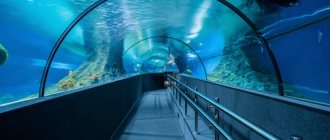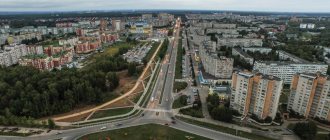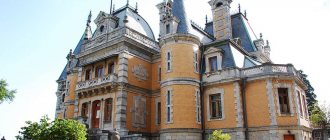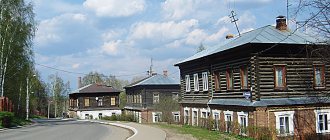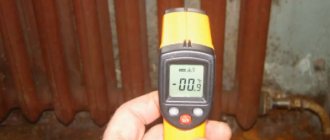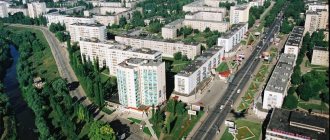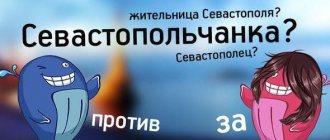Ermolino is an urban settlement located on the Protva River (a tributary of the Oka), 7 km from the Balabanovo railway station (on the Moscow - Bryansk line) and 13 km from the regional center - the city of Borovsk.
In the northeastern part of the Kaluga region, Ermolino borders on the rural settlements of the village of Sovkhoz Borovsky, the village of Sovyaki and the urban settlements of the city of Borovsk and the city of Balabanovo. The area of the municipality is 7.7 sq. km.
The population of the city is 10,179 thousand people.
The convenient geographical location of the city determines the connection with neighboring urban settlements, which is carried out by the federal highway A108 Moscow Big Ring and the Ermolino - Borovsk - Vereya highway, thereby predetermining its significant share in the industrial potential of the district and region.
The leading place in the city's economy is occupied by the woodworking, light and food industries.
Within the boundaries of the city of Ermolino there are lands of various categories: settlement, agricultural, forest fund, water fund. Agricultural lands, namely agricultural land and arable land, occupy about 6% (52 hectares) of the entire territory.
Brief historical background
The inventory list of the Vorsino parish, assigned to the Archangel Cathedral of the Moscow Kremlin, indicates that the parish included the villages of Kuryanovo, Inyutino and Ermakovo (Ermolino) of Borovsky district.
An extract has been preserved from the grant of a charter from Tsar Boris Godunov, given to the Arkhangelsk Cathedral on June 20, 1601. The extract indicates that these settlements were granted to the Arkhangelsk Cathedral by Prince Dmitry Shemyaka “by grandfather” Dmitry Donskoy (9a SEI, vol. 3 No. 51.p. 77-78). This reference goes back to the times of Dmitry Shemyaka and Dmitry Donskoy, who owned Sukhodol, which occupied the territory on the left bank of the river. Protva from Borovsk and Balabanovo to Nara.
Prince Dmitry Shemyaka led the feudal opposition to Grand Duke Vasily II. After the defeat of Dmitry Shemyaka in the feudal war of 1453, all his lands were taken away by Vasily II, and the charters for these lands were re-affirmed in favor of the church.
Next to the estate of the Archangel Cathedral were the lands of the Pafnutiev Monastery, founded in 1444 and which became one of the richest monasteries of the Russian state. The lands that belonged to the monastery were located in 16 counties. During the time of Dmitry Shemyaka, the village of Rusinovo also received a monastery (currently this is one of the streets in Ermolino, where the Church of St. Nicholas the Wonderworker, erected in 1830 in honor of the victory of Russian troops over Napoleon, is being restored).
Rich in animals and game birds, the Ermolin “purse” attracted Ivan the Terrible and Boris Godunov. Over time, the wealth of the forests became scarce, and the population that was engaged in agriculture increased. They sowed rye and oats, but preference was given to hemp and flax, from which they produced canvas and rope, including for sale. Borovsk monasteries purchased large quantities of canvas.
A sharp turn in the development of villages and settlements began in 1719 and is associated with the name of Peter I and his policy of strengthening the economic and military power of the Russian state. Tsar Peter I issued certificates to enterprising people to open plants and factories. Borovchan residents - the Kapyrin brothers - planned to build a “mining and iron-making” plant in a ravine near the village of Ermolino. Ten years later, the “foundry” produced up to 2 thousand pounds of cast iron. Coal was burned on site, and ore was delivered by alloy from Mozhaisk district, cast iron was transported by barges along the river.
After the abolition of serfdom, the merchant Molchanov built a small manufactory in Ermolino and launched the production of wrapping paper. In the second half of the 18th century, the weaving industry developed significantly in Ermolino and other settlements of Borovsky district. Handicraft weavers were engaged in the manufacture of paper and wool scarves, shawls, aprons and towels, blankets and even carpets.
The largest in Borovsky district was the Rusinovskaya textile factory of Alexandrov.
The former clerk of this factory, Fyodor Isaev, having successfully married the daughter of Pavel Bukharin, the owner of the Ermolinsk distribution office, took over his father-in-law’s capital and invested it in the development of new production, buying several acres of land near the river for next to nothing. In 1880, merchant of the 2nd guild Fyodor Semenovich Isaev received a Patent for opening the Ermolinskaya manufactory, which produces fabrics and printed scarves. Products are exported to the Turkish and Iranian markets and successfully compete with British goods.
The Ermolinsky factory, already at that time, had become one of the largest enterprises in the textile industry in Russia and directly influenced the development of the entire Ermolino and the surrounding villages of Rusinovo, Inyutino, etc. The population finally breaks with agriculture and joins the ranks of the working class. Weaving for Ermolin residents becomes a hereditary craft. The history of the factory is the history of Ermolino - from the Ermolino textile manufactory, the weaving factory "Krestyanka", the Ermolinsky production association, which employed more than three thousand people, to the modern textile enterprise Ermolino OJSC, from the village and workers' settlement to the city of Ermolino, where they live about 10 thousand inhabitants.
Single-industry town Ermolino
Requirements for the project and initiator (borrower)
- initiator (borrower) – individual entrepreneur or legal entity, resident of the Russian Federation;
- the initiator has no overdue debt to the budget and funds;
- as a result of the implementation of the Investment Project, investments should be made and new jobs should be created;
- lack of dependence of the project on the activities of the city-forming enterprise.
Restrictions
- the Fund's participation in the project is no more than 80% of the total cost of the project;
- the Fund's funds can only be used for capital investments;
- the presence in relation to the single-industry town of a general agreement on development cooperation concluded with a constituent entity of the Russian Federation (on the joint implementation of a comprehensive project).
An investment project in a single-industry town is understood as an investment project carried out in the form of capital investments by a legal entity or individual entrepreneur on a plot of territory consisting of one or more land plots within the boundaries of a single-industry town, as well as on areas of territory adjacent to the borders of a single-industry town within the boundaries of an industrial, industrial , technological or agro-industrial park, or if part of the production capacity of these persons is located outside the territory of the single-industry town, but is a component of a single production process aimed at achieving a common economic result (production of goods, performance of work, provision of services) and simultaneously meets the following requirements:
- the project is not an investment project for the reconstruction, technical re-equipment, modernization and (or) additional equipment of the city-forming enterprise of a single-industry town;
- the annual cost of goods (work, services) purchased from the city-forming enterprise of the single-industry town does not exceed 50% of the annual cost of all goods (work, services) purchased for the purpose of implementing the investment project;
- annual revenue from the sale of goods (work, services) of the city-forming enterprise of a single-industry town does not exceed 50% of the annual revenue received from the sale of goods (work, services) produced (performed, provided) as a result of the implementation of the investment project.
Obtaining the status of an industrial park is planned in 2022
Project initiator: K-Agro LLC and the Government of the Kaluga Region represented by the regional Ministry of Economic Development Project purpose: placement of enterprises of various industries, warehouse real estate. Land rights: property of K-Agro LLC Land category: industrial lands Investments: up to 58 billion rubles. Jobs: more than 5,500 jobs.
The total area of the industrial park is 288 hectares, of which:
- 1.5 hectares provided to investors
- 86.5 hectares allocated for communication corridors
- 200 hectares free for investors
Location
- The park is located along the federal highway A-108 “Bolshaya Betonka”
- 15 km from Obninsk, 95 km from Moscow and 95 km from Kaluga
- Highway M-3 "Moscow-Kyiv" at a distance of 5 km. Capacity of 1,250 cars per hour with four-lane traffic organization and the prospect of increasing to six lanes (to Kaluga)
- Highway M-1 “Moscow-Minsk” at a distance of 40 km
- The customs terminal is located on the western site of the Vorsino industrial park at a distance of 15 km
- Vorsino railway station is located 8 km away. Active. Work is underway on the station's track development
- The Obninskoye railway station is located 20 km from the industrial park
Distance to international airports
- “Sheremetyevo” – 120 km (approximate travel time – 2 hours)
- “Vnukovo” – 70 km (approximate travel time – 1 hour)
- “Domodedovo” – 110 km (approximate travel time – 1.5 hours)
Nearest settlements
- Ermolino (population 10 thousand people)
- Obninsk (population 118 thousand people)
- Balabanovo (population 25 thousand people)
- Naro-Fominsk (population 67 thousand people)
High population density
- More than 400 thousand people live within a radius of 50 km
- More than 6 million people live within a radius of 100 km
- More than 25% of the Russian population lives within a radius of 600 km
Residents of the industrial park
- KF "Mikaello", LLC - production of confectionery products
Infrastructure
Internal engineering infrastructure is in the design stage. The following mainline capacities are currently available:
Power supply - from the 110/35/10 kV Rusinovo substation,
Gas supply - from the medium pressure gas pipeline of Maloyaroslavetsmezhraigaz JSC (steel pipe Æ 159 mm)
Water supply - from the networks of the State Enterprise "Kalugaoblvodokanal", - organization of your own well
Water disposal - from the networks of the State Enterprise "Kalugaoblvodokanal" (Ermolinsky treatment facilities)
Conditions for accommodation on the territory of the industrial park
- placement for a fee (calculated individually for each investor)
Interesting Facts
- The status of a single-industry town was assigned to the city of Ermolino on January 21, 2022. This status is assigned to settlements with a population of more than 3 thousand people, of which about 20% are employed at the enterprises of one company (city-forming enterprise).
- The status of a single-industry town gives additional competitive advantages to companies located within the city boundaries. First of all, this is support from the Single-Industry Towns Development Fund (FMD):
- provision of funds in the form of a loan (from 5 million to 1 billion rubles for a period of up to 15 years with a deferment on loan repayment for up to 3 years at 0% per annum (if the loan is above 250 million rubles - 5% per annum);
— co-financing of expenses of constituent entities of the Russian Federation and municipalities for the construction and (or) reconstruction of infrastructure facilities.
- In the future, on the territory of the single-industry town of Ermolino, it is planned to create a territory with a preferential regime - a territory of advanced socio-economic development (PSED), which will allow residents, among other things, to claim tax benefits (reduced income tax rates, property taxes, tax rates in state funds).
Coat of arms
The coat of arms of the urban settlement "Ermolino City" was approved by decision No. 217 of the City Duma on December 26, 1999 and entered into the State Heraldic Register of the Russian Federation with the assignment of registration number No. 696.
The basis of the coat of arms of the city of Ermolino was its geographical location on the bend of the Protva River, depicted in the coat of arms with a winding silver ribbon.
Silver in heraldry
A symbol of simplicity, perfection, wisdom, nobility, peace, mutual cooperation.
Blue color in heraldry
A symbol of honor, glory, devotion, truth, beauty, virtue and clear skies.
The Ermolinsky Airlines cargo airport, which is allegorically depicted by a flying oriole, is inextricably linked with the sky.
A bird with a shield flying upward shows Ermolino’s aspiration to the future, not forgetting the origins of the formation of the city, which took place around the spinning and weaving factory, depicted in the shield as a shuttle.
Red color
A symbol of labor, life-affirming strength, courage, celebration and beauty.
Gold
A symbol of strength, greatness, intelligence, generosity.
Green color
Shows the nature surrounding the city, rich in fields, forests, meadows, as well as agriculture. Green is also a symbol of hope, life and rebirth.
The placement of the shuttle in a separate shield symbolizes the special significance of weaving in the history of Ermolino.
The Ermolino coat of arms was developed with the assistance of the Union of Heraldists of Russia.
Authors of the coat of arms
Idea
Konstantin Mochenov (Khimki), Sergey Isaev (Moscow), Vadim Blazhenkov (Ermolino)
Artist
Robert Malanichev (Moscow).
“They behave like masters of life.” Residents of Ermolino spoke about attacks by migrants
Information about the fight was spread in local public pages on the social network VKontakte. So, in an anonymous post in the community “Overheard in Balabanovo” it says
that the conflict was provoked by three Uzbeks who “decided to meet underage girls.” They didn’t want to communicate and called their friends, and a fight broke out between their friends and the visitors.
Elena, a friend of the victim’s family, told Gazeta.Ru that the student was simply passing by and accidentally got involved in the conflict.
“They were walking, and these non-Russians beat someone they already knew, and they interceded,” she explained.
According to Gazeta.Ru’s interlocutor, the guy survived and is in a hospital in Kaluga.
was reported to Podem
the victim's uncle. “My sister says that she and her friends were passing by, and these non-Russians were beating some guy, and he no longer showed signs of life. The guys came up to pull this guy away and that’s it,” he said. “Rise” clarifies that the fight happened near a public transport stop.
According to the uncle, his nephew suffered a “penetrating wound to the heart.” “Now I’m in serious condition, I haven’t recovered yet. They sewed up his heart,” he clarified.
Public “RIC | Borovsky district" reports
that the victim’s condition is serious but stable.
Police and local authorities have not yet confirmed that migrants were involved in the fight. The regional department of the Ministry of Foreign Affairs published a message
about the “citizen conflict” that occurred the day before, as a result of which a local resident born in 2005 was stabbed.
“Preliminarily, the cause of the incident was a domestic conflict,” the police clarified.
A criminal case of attempted murder has been opened. The police, “hot on the trail,” detained a young man born in 2001. The Ministry of Internal Affairs called him “possibly involved” in the crime. In addition, the identities of four more citizens involved in the incident have been established. The citizenship of none of them is disclosed.
The administration of the Borovsky district confirmed the fact of the fight in Ermolino and that no one died as a result of the conflict.
“Walking in the evening is scary”
Interlocutor of “Newspapers. Ru” said that this is not the first time that residents of Ermolino have suffered from migrants. “Recently, a 26-year-old guy from Ermolino was killed; his daughter is only a year and a half old. There are many different cases that no one knows anything about,” she said.
Subscribers to local public pages also say that such news from Ermolino “is no longer surprising.” “It’s scary to let my daughter leave home. [Newcomers] behave freely. As masters of life. It’s scary to walk in the evening,” Valentina wrote.
“Our children go to dances in the evening, there are a lot of them there near the recreation center, just at this time,” writes Olga, another subscriber.
As subscribers note, migrants used to “bypass Ermolino” because local residents “quickly taught them.” Residents of the city explained that there is a factory in Ermolino where migrants are “brought by bus.”
“They need to know our customs”: how Russia will solve the problem of migrants
Russian President Vladimir Putin, at a meeting with members of the Human Rights Council, said that...
09 December 19:49
While the police are checking what happened, locals are complaining about the inaction of the authorities. Some are calling on the city administration to conduct monthly raids and check on migrants. Readovka writes:
, local residents want to organize a “people’s gathering” at the Ermolino administration.
“It’s high time to hold some kind of meeting and limit them at least at the local level. This wasn’t just a fight—people had knives. And how should you hit it to penetrate?” - residents are interested.
Many migrants come to the Kaluga region, especially to its northern part, which is adjacent to the Moscow region. In January, this was confirmed by the region’s Minister of Education, Alexander Anikeev, who explained that the authorities themselves are striving to attract labor. “Our region is pursuing a very active investment policy, attracting labor - hence the large influx of migrants, especially to the northern regions adjacent to the Moscow region. In quite a large number of schools in these areas, foreign children study - mostly immigrants from the CIS countries and Central Asian states. There are schools where the proportion of children for whom Russian is not their native language exceeds half and even two-thirds,” the Telegram channel quotes the minister.
